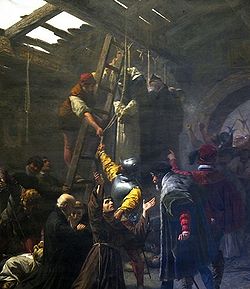- Martyrs of Gorkum
-
The Martyrs of Gorkum 
by Cesare FracassiniBorn 16th century Died July 9, 1572,Brielle Martyred by The Watergeuzen Means of martyrdom hanging Venerated in Roman Catholic Church Beatified November 14, 1675, Rome
by Pope Clement XCanonized June 29, 1865, Rome
by PopePius IXFeast July 9 Notable martyrs Nicholas Pieck, Hieronymns of Weert, Theodorus van der Eem, Nicasius Janssen, Willehad of Denmark, Godefried of Mervel, Antonius of Weert, Antonius of Hoornaer and Franciseus de Roye The Martyrs of Gorkum were a group of 19 Dutch Catholic clergy and friars who suffered martyrdom in the sixteenth century for their faith in the town of Gorinchem (or Gorkum).
Contents
Events
By 1572, Martin Luther and John Calvin had already wrested from the Catholic Church a great part of Europe. A storm of iconoclasm had swept through the Seventeen Provinces of the Low Countries, and was followed by a struggle between Lutheranism and Calvinism in which the latter was victorious. In 1571, the Calvinists held their first synod, at Emden. Because of the anti-Protestant edicts and persecution by the Spanish government, on 1 April of the next year the Watergeuzen or Gueux de mer (water-/sea-beggars, i.e., rebels), rebelled against the Spanish Habsburg crown which ruled the Low Countries, conquered Brielle and later Vlissingen and other places.
In June, Dordrecht and Gorkum fell into their hands and at Gorkum they captured nine Franciscans: Nicholas Pieck, guardian of Gorkum; Hieronymns of Weert, vicar; Theodorus van der Eem of Amersfoort; Nicasius Janssen of Heeze; Willehad of Denmark; Godefried of Mervel; Antonius of Weert; Antonius of Hoornaer and Franciseus de Roye of Brussels. To these were added two lay brothers from the same monastery, Petrus of Assche and Cornelius of Wijk bij Duurstede. At almost the same time the Calvinists arrested the learned parish priest of Gorkum, Leonardus Vechel of 's-Hertogenbosch, who had made distinguished studies in Louvain, and also his assistant Nicolaas Janssen, surnamed Poppel, of Welde in Belgium. With the above were also imprisoned Godefried van Duynsen of Gorkum, who was active as a priest in his native city, and Joannes Lenartz of Oisterwijk, an Augustinian and director of the convent of Augustinian nuns in Gorkum. From the very beginning these men suffered considerable torment in the prison.
To these fifteen were later added four more companions: Joannes van Hoornaer (alias known as John of Cologne), a Dominican of the Cologne province and parish priest not far from Gorkum, who when apprised of the incarceration of the clergy of Gorkum hastened to the city in order to administer the sacraments to them and was seized and imprisoned with the rest; Jacobus Lacops of Oudenaar, a Norbertine, who after leading a frivolous life, being disobedient to his order, and neglectful of his religious duties, reformed, became a curate in Monster, Holland, and was imprisoned in 1572; Adrianus Janssen of Hilvarenbeek, at one time a Premonstratensian and parish priest in Monster, who was sent to Brielle with Jacobus Lacops; and lastly Andreas Wouters of Heynoord, whose conduct was hesitant up to the time of his arrest, but also ended in martyrdom.
After enduring much abuse and suffering in the prison at Gorkum (26 June-6 July) the first fifteen prisoners were transferred to Brielle, arriving there on 13 July. On their way to Dordrecht they were exhibited for money to the curious. The following day, William de la Marck, Lord of Lumey, commander of the Gueux de mer, had them interrogated and ordered a disputation. In the meantime, the four others also arrived. It was demanded of each that he abandon his belief in the Blessed Sacrament and in papal supremacy. All remained firm in their faith. Meanwhile there came a letter from the prince of Orange, William the Silent, which enjoined all those in authority to leave priests and religious unmolested. Nevertheless during the night of 9 July Lumey had them hanged in a turfshed and is alleged to have mutilated the bodies.
Veneration
Their beatification took place on 14 November 1675, and their canonization on 29 June 1865.
For many years the place of their martyrdom in Brielle has been the scene of numerous pilgrimages and processions.
The reliquary of their remains is now enshrined in the Church of Saint Nicholas, Brussels, Belgium.
References
 This article incorporates text from a publication now in the public domain: Herbermann, Charles, ed (1913). "The Martyrs of Gorkum". Catholic Encyclopedia. Robert Appleton Company.
This article incorporates text from a publication now in the public domain: Herbermann, Charles, ed (1913). "The Martyrs of Gorkum". Catholic Encyclopedia. Robert Appleton Company.External links
- "SS. Martyrs of Gorcum", Butler's Lives of the Saints
Categories:- 16th-century births
- 1572 deaths
- Lists of Christian martyrs
- Dutch saints
- Dutch Roman Catholic saints
- Eighty Years' War
- History of the Netherlands
- Articles about multiple people
- 16th-century Christian saints
- 16th-century Roman Catholic martyrs
- Franciscan martyrs
- Franciscan saints
- Premonstratensians
- Members of the Dominican Order
- Dutch Roman Catholic priests
- People canonized by Pope Pius XII
Wikimedia Foundation. 2010.

